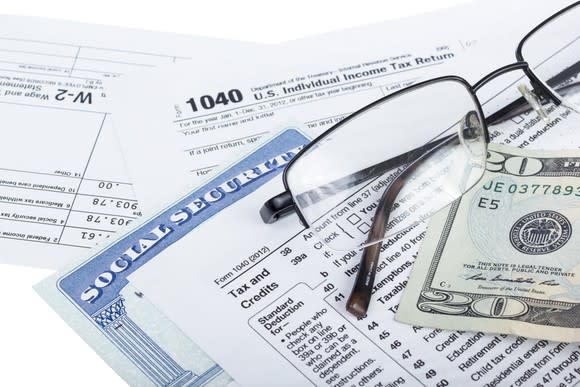1 of the 13 States Taxing Social Security Benefits Is Making Big Changes
Social Security is a program that tens of millions of Americans currently lean on in retirement. Close to 70% of all beneficiaries are of retirement age, and some 62% of these retirees counts on their monthly stipend for at least half of their income.
Yet, as important as Social Security is for the American public, not a lot is actually understood about the program. Regular polling tells us this is true. Back in 2015, MassMutual Financial Group conducted an online, 10-question, true-false quiz on Social Security. The questions covered were considered basic knowledge topics that informed beneficiaries should be able to answer. Of the 1,513 people to have taken the quiz, just 28% scored seven question or more correct to get what would traditionally be considered a "passing score." Only one person out of the entire lot managed to get all 10 questions correct; and even missing one question could be the difference between getting everything you deserve, and leaving money on the table during retirement.

Image source: Getty Images.
The taxation of Social Security benefits can be a surprise for a lot of people
Though there are plenty of aspects of Social Security that can surprise beneficiaries during their golden years, perhaps none stands out more than the taxation of benefits. Yes, that's right: Your Social Security benefits may be subject to federal taxation.
Back in 1983, the Reagan administration was facing a long-term (75-year) actuarial deficit that was about a third of what we're currently facing, and it passed the last sweeping reforms to the program. It cut long-term costs by gradually raising the full retirement age over the course of four decades, and it looked to generate additional revenue. One of the means of doing so was by initiating the taxation of benefits over a certain adjusted gross income (AGI) threshold.
When Social Security benefits first became taxable in 1984, single taxpayers earning more than $25,000 in AGI, and couples filing jointly with more than $32,000 in AGI, were subject to having half of their benefits taxed at the federal ordinary income tax rate. In 1993, the Clinton administration added another tier, allowing 85% of Social Security benefits to be exposed to federal ordinary income tax if AGI for single taxpayers and couples filing jointly surpassed $34,000 and $44,000, respectively.
Here's the interesting (and hated) aspect of the taxation of benefits at the federal level: The income thresholds signed into law in 1983 and 1993 have never been adjusted for inflation. A tax that once impacted only around 10% of senior households when it was first signed into law now affects 56% of senior household, according to The Senior Citizens League.

Image source: Getty Images.
Surprise! 13 states tax Social Security benefits, too
But it's not just the federal government getting in on the act. Some 13 states also tax Social Security benefits, to a degree. In alphabetical order, these states are:
Colorado
Connecticut
Kansas
Minnesota
Missouri
Montana
Nebraska
New Mexico
North Dakota
Rhode Island
Utah
Vermont
West Virginia
Four of these states -- Minnesota, North Dakota, Vermont, and West Virginia -- mirror the federal government's tax schedule for Social Security. The remaining states offer varying levels of exemptions.
For example, Missouri has what's arguably the most generous Social Security tax exemptions of any of these 13 states. In Missouri, single taxpayers would have to earn above $85,000 in AGI and married couples filing jointly in excess of $100,000 in AGI in order to pay additional tax on Social Security benefits to the state. Similarly generous exemptions are divvied up in Rhode Island and Kansas.

Image source: Getty Images.
This Social Security-taxing state is making big changes
However, one of these 13 states is about to make some pretty sweeping changes.
Connecticut's legislature, which had been tinkering with the idea of doing away with its Social Security tax altogether at one point, recently announced a sizable, and likely welcome, increase in the AGI thresholds set to take effect in 2019.
For those unfamiliar, Connecticut has been allowing individuals with AGIs of $50,000 or less and couples filing jointly with $60,000 in AGI or less to deduct 100% of their Social Security income. That's considerably higher than the federal tax schedule, but it should also be noted that Connecticut has one of the highest average household incomes in the country.
Beginning in 2019, individual taxpayers receiving Social Security benefits can deduct the entirety of those benefits while earning as much as $75,000 in AGI. Couples filing jointly can deduct the full amount as well by earning up to $100,000 in AGI. Consistent with the current law, individuals and couples exceeding these thresholds will still be able to deduct 75% of their Social Security benefits at the state level.
With these new thresholds, it's even less likely that retirees in Connecticut will be taxed on their Social Security benefits at the state level. It's also a great reminder that not all Social Security taxing states need to be avoided. Those with sufficiently high income thresholds -- of which Connecticut is certain to belong on that list as of next year -- ensure that most senior households will avoid state-level taxation.
More From The Motley Fool
The Motley Fool has a disclosure policy.

